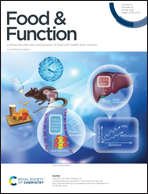Mass spectrometry-based serum lipidomics strategy to explore the mechanism of Eleutherococcus senticosus (Rupr. & Maxim.) Maxim. leaves in the treatment of ischemic stroke†
Abstract
Eleutherococcus senticosus (Rupr. & Maxim.) Maxim. leaves (ESL) were reported to have neuroprotective function and are also used to treat cranial and cerebral traumas as a traditional Chinese medicine and food herbage plant. However, there has been no previous study on ESL treatment for stroke at the level of lipid disorders. To clarify the mechanism of ESL in treating ischemic stroke, this study was carried out from 3 aspects, namely, the regulation of lipid disorders, protection of the nervous system, as well as anti-inflammatory and antioxidant actions. This study established a lipidomics research strategy that was developed by UPLC-Q-TOF/MS analysis. The quantification of neurotransmitters in the serum and brain tissue of rats was performed using UPLC-TQ/MS. Also, we quantified the oxidative stress and inflammatory reaction by measuring the contents of SOD, MDA, TNF-α, IL-6, and IL-10 via the ELISA kits for serum and brain tissue. According to UPLC-Q-TOF/MS-based lipidomics analysis, 27 lipidomics biomarkers were identified in this study, including PC, PE, SM, and TG, which were distributed in various lipid metabolic pathways, including glycerophospholipid, linoleic acid, alpha-linolenic acid, glycerolipid, sphingolipid, and arachidonic acid metabolism pathways. By reversing the changes in the lipid content caused by the disease, ESL has a therapeutic effect on ischemic stroke. Furthermore, quantitative results of neurotransmitters indicated that they can be regulated by ESL. Finally, the results of ELISA showed that ESL can treat ischemic stroke to a certain extent by reducing the oxidative and inflammatory damage. Therefore, ESL may play a therapeutic role in the treatment of ischemic stroke in different ways. This research preliminarily revealed the mechanism of ESL in the treatment of ischemic stroke and provided support for the further application of ESL.



 Please wait while we load your content...
Please wait while we load your content...